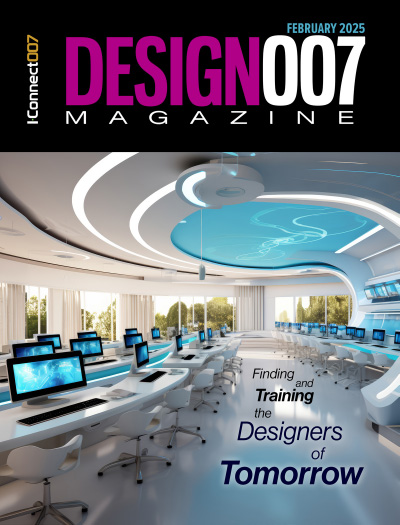-

-
News
News Highlights
- Books
Featured Books
- design007 Magazine
Latest Issues
Current Issue
Learning to Speak ‘Fab’
Our expert contributors clear up many of the miscommunication problems between PCB designers and their fab and assembly stakeholders. As you will see, a little extra planning early in the design cycle can go a long way toward maintaining open lines of communication with the fab and assembly folks.

Training New Designers
Where will we find the next generation of PCB designers and design engineers? Once we locate them, how will we train and educate them? What will PCB designers of the future need to master to deal with tomorrow’s technology?

The Designer of the Future
Our expert contributors peer into their crystal balls and offer their thoughts on the designers and design engineers of tomorrow, and what their jobs will look like.
- Articles
- Columns
Search Console
- Links
- Media kit
||| MENU - design007 Magazine
Estimated reading time: 1 minute
Beyond Design: The Maturing EDA Industry
The EDA industry has evolved from its humble, free-for-all, Wild West beginnings into a mature industry employing a record 35,000 professionals and turning over a staggering $2 billion per quarter. Whilst the Americas market is still recovering, Asia-Pacific and Japan have experienced double digit growth. But Europe the Middle East and Africa (EMEA) have experienced a downturn over the past quarter.
Cadence Design Systems, Mentor Graphics, and Synopsys, a.k.a. “The EDA Big Three,” have realized significant growth in IC design and signoff and the functional verification sectors. However, revenue for the PCB segment grew just 5.3% in 2014 to $853.1 million.
Although only a small part of the total EDA revenue, the PCB sector has a different pecking order: Mentor Graphics, Cadence, Zuken, Altium, Pulsonix, Intercept Technology and CadSoft. Mentor, Cadence and Zuken are all competing in the enterprise and the mainstream markets and all have double-digit market share. In terms of seat count, Altium, the relative new kid in town, is lower in the spectrum, but positioning themselves into enterprise-level solutions.
There are also many free or low-cost PCB applications available such as KiCad, Diptrace, Toporouter, DesignSpark, Circuit Maker, PCB123 and PCB Artist to name a few. But these packages mainly cater for the electronics enthusiast or entry-level market.
The major EDA revenue streams come from the following operations:
- Perpetual and term licensing of EDA software and intellectual property
- Software support and post-contract maintenance
- Professional services, including consulting and training
EDA companies generally innovate through acquisitions and mergers as it is easier to buy new technology than expend time and resources developing a product and risk losing market share. However, some tend to focus on partnering with other EDA vendors rather than acquisition. But this leaves them vulnerable to outside influence. Many small EDA start-ups develop niche technology, an innovation that adds value in a specific area. But their fast growth soon reaches a burn-rate threshold whereby their momentum can no longer be sustained. These companies are ripe for the picking, as their technology can be merged into existing applications to provide an end-to-end solution.
To read this entire article, which appeared in the December 2016 issue of The PCB Magazine, click here.
More Columns from Beyond Design
Beyond Design: Key SI Considerations for High-speed PCB DesignBeyond Design: Electro-optical Circuit Boards
Beyond Design: AI-driven Inverse Stackup Optimization
Beyond Design: High-speed Rules of Thumb
Beyond Design: Integrated Circuit to PCB Integration
Beyond Design: Does Current Deliver the Energy in a Circuit?
Beyond Design: Termination Planning
Beyond Design: Dielectric Material Selection Guide


